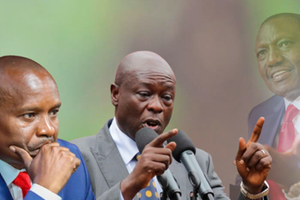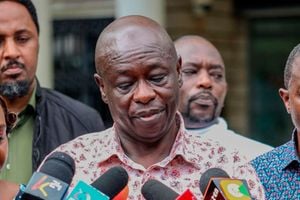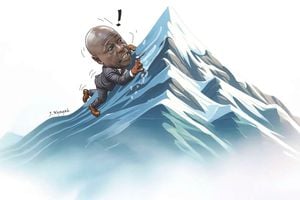
Wiper Party leader Kalonzo Musyoka, DAP-K Party's Eugene Wamalwa, Jubilee Secretary-General Jeremiah Kioni and former Kiambu governor Ferdinand Waititu attend a church service at PCEA Umoja Church in Nairobi on November 10, 2024.
As the Mount Kenya region continues to be the epicentre of explosive politics, with its de facto leader, Rigathi Gachagua, toppled as Deputy President, focus has shifted to the game plan for the 2027 General Election. This plan appears to revolve around two opposing forces: the growing opposition to President Ruto and loyalists who, despite facing hostility, hope for a comeback to restore his near-fanatical support from the 2022 elections.
The region is now split between President William Ruto’s loyalists, mainly MPs, and critics of the Head of State, who are leveraging Gachagua’s ouster and voter dissatisfaction with recent actions by the Kenya Kwanza administration.
President Ruto has since endorsed Deputy President Prof Kithure Kindiki as his point man for Mount Kenya. On Monday, Prof Kindiki was installed as the United Democratic Alliance’s Deputy Party Leader after successfully mobilising the National Assembly and the Senate to impeach Mr Gachagua.
Some argue that the region should engage President Ruto for development, while others suggest a complete split, with anti-government plans for 2027 commencing immediately.
The ground appears largely to be rallying around Mr Gachagua, who has promised to provide political direction for the region.
The opposition to President Ruto and his allies remains unrelenting, a factor political pundits believe could present a challenge for the President in maintaining the 87 per cent support he received in the 2022 General Election.
Political alliances
“Fears linger that the Mountain is seeking a different path away from President Ruto ahead of 2027, which is drawing the interest of political alliances,” says political analyst Harman Manyora. Mr Manyora points out that among those rumoured to be eyeing a Mount Kenya alliance is Mr Raila Odinga, currently regarded as a key player in President Ruto’s government.
The region’s voting patterns have traditionally been influenced by shared language, prominent financial backers, agricultural demands, and the one-man-one-shilling formula. President Ruto dismissed the latter during Mashujaa Day celebrations as “repugnant, seeking to discriminate, isolate, and marginalise others.” Former Gatanga MP Nduati Ngugi notes that the formula recently gained the support of Mr Odinga, creating concerns among the President’s supporters that Mount Kenya could align with the Lake Basin region ahead of 2027.
Kapseret MP Oscar Sudi recently visited Meru County, where he criticised parts of the Mountain that consider themselves “special and unique... this is a foolish mentality.” Until his recent impeachment, Mr Gachagua was seen as the region’s shepherd. However, his impeachment, which he is now challenging in court, could disqualify him from contesting the next two general elections. While some still regard former President Uhuru Kenyatta as the best leader for the bloc, Mr Gachagua had become the main point of influence in the region.
According to political scientist Gasper Odhiambo, the President’s handlers began expressing discontent with Mr Gachagua as early as 2022, when some Mount Kenya politicians called for his replacement. The visible rapport between Mr Gachagua and Mr Odinga, who both became popular with the Gen Z demographic, led to Mr Gachagua’s impeachment and the inclusion of Mr Odinga through a broad-based government structure.
Level playing field
“When Mr Gachagua began to assert himself, a decision was made to ‘dehorn’ him through impeachment. This set in motion efforts to level the playing field in the Mountain, turning it into a political landscape of equal opportunity,” said Mr Odhiambo.
Makueni Senator Dan Maanzo warned that without external support, the schemes designed to disperse Mount Kenya’s voter base for easier control are sophisticated and elaborate. “Mr Maanzo stated, “The more the region entertains President Ruto’s divide-and-rule tactics, the more difficult it will be to reorganise after the injustice done to Mr Gachagua.” He continued, “Efforts to pit brothers and sisters against each other culminated in the capture, humiliation, and deposition of their battalion leader, Gachagua. However, he expressed optimism, citing alliances with Wiper Party leader Kalonzo Musyoka, DAP-Kenya leader Eugene Wamalwa, and others who recognise the Gikuyu, Embu, and Meru communities’ significant voting power.
Meanwhile, Mr Musyoka is positioning himself as a 2027 presidential candidate with support from local figures, including Jubilee Party Secretary General Jeremiah Kioni and former Kiambu Governor Ferdinand Waititu.
The leadership in Mount Kenya remains divided. Kiama Kia Ma national patron Mr Kung’u Muigai insists that “Gachagua is fighting a losing battle and must vacate the command post,” while Kikuyu Council of Elders Chairman Wachira Kiago advocates for unity within the region. Gema Chairman Mr Lawi Imathiu suggests dialogue with the government to focus on development, noting that “unity for the benefit of our people is essential, especially when seeking improvements in quality of life.”
In a cautionary note, Mumias East MP Peter Salasya advised the region to organise itself to resist external manipulation. However, Laikipia East MP Mwangi Kiunjuri advocated a pragmatic approach, emphasising cooperation with the current administration for service delivery.
“Mount Kenya must settle down, curb emotions, and demand the services that were promised during the campaigns,” said Kiunjuri.











